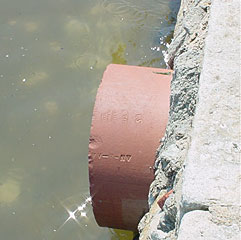 |
 |
Policy and Management

Pollution
Water pollution can be defined, as a change to water that is harmful to organisms. There is a large number of people that live around estuaries and pollution is usually caused by human impacts. The potential pollutants most often found in most estuaries include nutrients, bacteria and viruses, and metals. Background, or low-level, concentrations of these contaminants are constantly present in all aquatic systems as a result of various natural processes. These materials become pollutants when they are found in excess, and have a harmful effect on water quality. Pollution is generally attributed to human activity, and is measurable. There are two general categories of pollution:
Point source pollution emanates from a specific, easily identifiable source that discharges directly to a waterbody. Examples of point sources include pipes discharging directly to a waterbody, outfalls, and combined sewer overflows (CSOs).
Non-point source pollution comes from many sources. As runoff from rainfall or melting snow moves over (or through) the ground, it picks up and carries away natural and human-made pollutants. These pollutants are transported via runoff to rivers, lakes, and other waterbodies. Non-point source pollution is most likely to occur during wet weather, when runoff is increased.
Though these components do occur naturally in Narragansett Bay, human activity has increased the levels of nutrients, bacteria, viruses, and metals to pollution status. Polluted waters occur mostly in the upper portion of Narragansett Bay where the population is most dense, there is reduced tidal flushing, and there are numerous discharges to the Bay from combined sewer overflows, wastewater treatment facilities, and other sources.
Historically, wastewater treatment facilities and combined sewer overflows have been the main sources for pollution in the upper Bay. However as wastewater treatment facilities have been constructed, maintained, and upgraded and regulatory measures have been implemented, the water quality of Narragansett Bay has improved dramatically. Continued improvement of conditions in the upper Bay is expected as the Narragansett Bay Commission (NBC) begins the Combined Sewer Overflow Abatement Project and continues to develop and expand pollution prevention programs.
 (Image credits are listed in Image Index)
(Image credits are listed in Image Index)
|
 |


